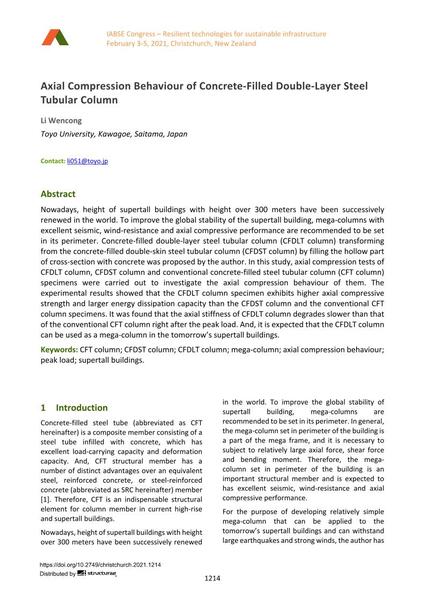Axial Compression Behaviour of Concrete-Filled Double-Layer Steel Tubular Column

|
|
|||||||||||
Bibliografische Angaben
| Autor(en): |
Li Wencong
(Toyo University, Kawagoe, Saitama, Japan)
|
||||
|---|---|---|---|---|---|
| Medium: | Tagungsbeitrag | ||||
| Sprache(n): | Englisch | ||||
| Tagung: | IABSE Congress: Resilient technologies for sustainable infrastructure, Christchurch, New Zealand, 3-5 February 2021 | ||||
| Veröffentlicht in: | IABSE Congress Christchurch 2020 | ||||
|
|||||
| Seite(n): | 1214-1221 | ||||
| Anzahl der Seiten (im PDF): | 8 | ||||
| DOI: | 10.2749/christchurch.2021.1214 | ||||
| Abstrakt: |
Nowadays, height of supertall buildings with height over 300 meters have been successively renewed in the world. To improve the global stability of the supertall building, mega-columns with excellent seismic, wind-resistance and axial compressive performance are recommended to be set in its perimeter. Concrete-filled double-layer steel tubular column (CFDLT column) transforming from the concrete-filled double-skin steel tubular column (CFDST column) by filling the hollow part of cross-section with concrete was proposed by the author. In this study, axial compression tests of CFDLT column, CFDST column and conventional concrete-filled steel tubular column (CFT column) specimens were carried out to investigate the axial compression behaviour of them. The experimental results showed that the CFDLT column specimen exhibits higher axial compressive strength and larger energy dissipation capacity than the CFDST column and the conventional CFT column specimens. It was found that the axial stiffness of CFDLT column degrades slower than that of the conventional CFT column right after the peak load. And, it is expected that the CFDLT column can be used as a mega-column in the tomorrow’s supertall buildings. |
||||
